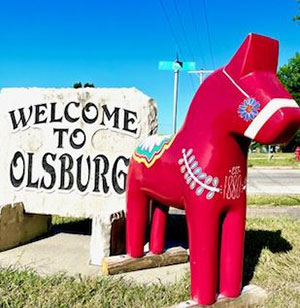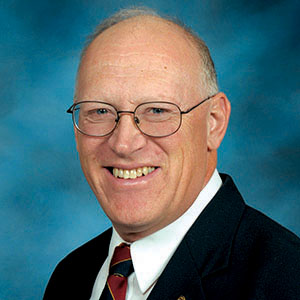Kansas Profile – Now That’s Rural: Tami Howland, dala horses
May 24, 2023
By Ron Wilson, director of the Huck Boyd National Institute for Rural Development at Kansas State University
 The horses are out! They’re all over town!
The horses are out! They’re all over town!
But these horses aren’t running away; they are standing strong for their community.
These are dala horses, the beautifully decorated horse-shaped figures that are a symbol of Sweden. Today we will visit a rural Kansas community that is using dala horses to beautify the town and engage its people.
Tami Howland is president of Olsburg’s Kansas PRIDE program, now known as Kansas Community Empowerment. Howland also works at Union State Bank in Olsburg.
The town was founded in 1880 by an immigrant Swede named Ole Thrulson. Originally named Olesburgh, the name was later shortened to Olsburg. One Swedish tradition is the display of dala horses: wooden carvings of horses that are painted and displayed outside homes and businesses.
PRIDE members wanted to enhance the community. In 2021, they received an anonymous donor’s gift to be used for beautification.
Using the Swedish theme, PRIDE members decided to launch a public art project consisting of large dala horses to be decorated by local businesses and organizations. The project received a matching grant from the Kansas Creative Arts Industries Commission, which is supported by the National Endowment for the Arts. PRIDE members contacted a Nebraska company that produced fiberglass dala horses 3 1/2 feet tall.
“We gave one to every business, church, and the school in town. We supplied paint and brushes for them to decorate each one as they wanted,” Howland said. “The only rules were: Nothing political, and nothing vulgar.”
In 2021, Olsburg PRIDE ordered 25 dala horses. “Immediately, we needed more,” Howland said. The horses were individually painted by each business or organization and then clear-coated by a nearby auto restoration company before being displayed outside at each site. Each horse also was named.
Then people learned that they could buy and paint their own. “Some people said, `But I’m not Swedish,’” Howland said. “Then they saw how different people were using them and the idea took off.”
“The creativity has been amazing,” she said. “Everybody had such great ideas.”
The dala horse named Ole stands next to the town;s ‘Welcome to Olsburg’ sign.
A red-white-and-blue horse named Liberty stands in front of the American Legion.
The one by the school is decorated like the school mascot.
The one named Stamps is at the post office.
The local veterinarian has one named Cupcake, who is displayed tied to a gate.
The one named Esther Williams is on a surfboard above the swimming pool.
The list goes on and on. It appears the citizens of Olsburg are having too much fun with this project.
Each one is individually and intricately hand painted by local people, including Howland herself. “I love to paint, it’s a fun thing for me,” she said. The painters range in age from six to 90. The horses are extraordinarily well-done. They are really works of art.
“It’s amazing how much talent comes out in our small town,” Howland said. Not only are the dala horses populated throughout Olsburg, several are displayed near homes in the outlying region. Howland’s cousin has one in Nebraska and another is en route to Oklahoma.
In December 2022, the first eight came back from clear-coating. Howland put them out as a Christmas display, placing them in a line followed by a miniature sleigh and Santa. The pictures she posted got a response from as far away as Sweden itself.
“I’m so proud of the way our community has embraced this idea,” she said. “It makes my heart smile.”
Now there are 47 dala horses in town. “We have more dala horses per capita than anywhere in the nation,” Howland said.
That’s impressive for a rural community such as Olsburg, population 218 people. Now, that’s rural.
“We want people to come see and enjoy them,” Howland said. For more information, see www.olsburgks.com/dala-horses.
It’s time to leave Olsburg, where Ole the dala horse stands proudly next to the Welcome to Olsburg sign. We salute Tami Howland and all the volunteers who are making a difference with their public art.
I join Ole in saying “Valkommen.”
Audio and text files of Kansas Profiles are available at http://www.kansasprofile.com. For more information about the Huck Boyd Institute, interested persons can visit http://www.huckboydinstitute.org.
***


